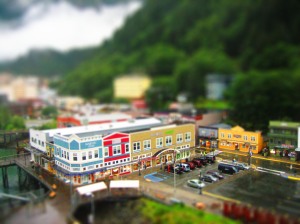Under normal circumstances, photographing with a wide open aperture will result in a shallow depth of field. However, this effect is not as noticeable for larger scale subjects in the distance, like with landscape photography. Tilt-shift photography is a technique used to achieve very selective focus where it’s not normally possible. Think of it as “large-scale blurrybacking”. 🙂
In the end, it is often used to fake miniatures and, while I have yet to determine the practical application of creating model-looking scenes out of real world photos, I can’t deny the fun I derive from tilt-shifting photos. 🙂
Tilt-shifting with Software
Historically, tilt-shifting is achieved with a special lens that (a) tilts the plane of focus to control the part of image the appears sharp and (b) shifts the lens plane to adjust the position of the subject. And while the science all sounds very technical and well over my head, the important thing to understand is that it basically makes photos look like they’re scenes out of Thomas & Friends. 🙂 And even more important, it’s possible to fake this effect with just a bit of post-processing and without the expensive lens.
There’s a ton of great tutorials, but the gist is:
- Simulate a shallow depth of field using a lens blur with a gradient mask, and
- Simulate the artificial polystyrene look by cranking the saturation and tweaking the colour curve for more contrast
Bring out the GIMP
Most of the tutorials use Photoshop, but licenses are not cheap by any means. Fortunately, GIMP is a great open-source alternative that won’t cost you a penny.
At some point in the future, I’ll likely post a step-by-step tutorial for the basic and advanced method of tilt-shifting with GIMP. But in the meantime, this Photoshop tutorial also works great for GIMP, with just a couple of exceptions:
Step 3. Photoshop’s “reflected gradient” option is the same as GIMP’s “bi-linear gradient shape” option.
Step 7 and 8. A GAUSSIAN or FOCUS blur should both work, I’ve generally used between 15-25 for the blur radius with either option.
Alaskan Cruise after my Cosmic Shrinking Ray!
Click on any of the images below to enlarge:

















These look like miniatures after your are done. So cool!